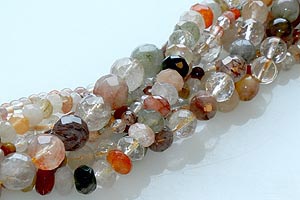Rings & Things Jewelry Blog
Gemstone Index: Tourmaline
The official state gemstone of Maine, tourmaline is a complex crystalline silicate containing aluminum, boron and other elements. Its name derives from the Sinhalese (Sri Lankan) word tura mali, meaning "stone of mixed colors," and tourmaline is indeed found in blue (indicolite), yellow, pink to red (rubellite), black (schorl), green, dravite (brown) and clear (achroite) varieties. We usually carry black, pink, and multicolor tourmaline beads.This semiprecious gemstone is piezoelectric (when it'
…
Feb 22nd 2023
Gemstone Index: Pearls
Pearls are June's most-popular birthstone, and are a favorite in bridal jewelry and couture. Cultured freshwater pearl beads come in several shapes and colors, making it easy to add elegance to a wide variety of jewelry designs - pearls aren't just for bridal designs, weddings and proms! Pearls are organic gemstones, formed when a foreign object (like a tiny stone) makes its way into an oyster (or similar mollusk's) shell. Over time, the mollusk covers the intruding object with 1,000's of layers
…
Feb 22nd 2023
Gemstone Index: Ruby
From royal crowns to Dorothy's slippers to, of course, delicious jewelry, the ruby is a most desirable gemstone. Its hardness, durability, luster and rarity are among the world's finest, and its blazing red color is beyond compare. Ruby is the red variety of the corundum (aluminum oxide) mineral, a family that also includes sapphire, and takes its name from the Latin rubeus or ruber, meaning "red." Corundum (which sapphires and rubies are comprised of) is the second-hardest natural mineral know
…
Dec 5th 2022
Gemstone Index: Serpentine
Serpentine is a lovely green translucent, waxy silicate of magnesium. it is often mistaken for various types of jade, and some stones called "jade" are actually types of serpentine. A major difference between the two semi precious stones is that serpentine is softer and less dense than most real jade. Its name comes from the word "serpent," or snake, perhaps because of its mottled green colors and patterns that can resemble snakeskin. Most of serpentine's history is tied in with the histo
…
Sep 20th 2022
Gemstone Index: Apatite
Apatite Gemstone Beads from Rings & Things: The name apatite is quite appropriate, considering this mineral makes up the teeth in all vertebrate animals (and teeth are used to satisfy one's appetite!). In fact, it comprises more than 60% of the bones and teeth in humans, fish, birds, cows, and even mammoths and dinosaurs. Apatite is a calcium phosphate that is typically green, but also can be blue, yellow, reddish-brown, violet, yellow-green ("asparagus stone"), colorless or multicolored.
…
Aug 15th 2022
Gemstone Index: Jade
For centuries, the word jade applied to green gemstones brought to Europe from China and Central America. It wasn't until 1863 that society realized the term "jade" was being applied to two different minerals. These two gemstones, nephrite and jadeite, are relatively hard to distinguish from each other, and both are still called jade. Varieties of serpentine have also been confused with jade throughout history, and some serpentine is still called jade. In fact, the Chinese word for jade is appli
…
Jul 1st 2022
Gemstone Index: Quartz
Quartz gemstone beads and pendants from Rings & Things: Options include multicolor rutilated quartz, clear rock crystal quartz, rose quartz, smoky quartz, tourmalated quartz, druzy quartz and more. Members of this semiprecious gemstone family share the same chemical composition (silicon dioxide) and similar physical properties. All semiprecious beads described here are types of macrocrystalline quartz (crystals recognizable with the naked eye), just like citrine and amethyst. True quartz can
…
Dec 30th 2021
Gemstone Index: Opal
Opal Gemstone Beads from Rings & Things: Opal beads have the same basic chemical composition as quartz, but usually contain 6 - 10% water. Because of this, opal jewelry components should be protected from heat and strong light. Loss of water can cause opals to crack and/or lose iridescence. Opal beads can be oiled to prevent dehydration. Make sure to keep your opal beads away from detergents, ultrasonic cleaners, metal polish, acids and strong solvents. Birthstones for October include Opal,
…
Dec 29th 2021
Gemstone Index: Jasper
Jasper is a semiprecious chalcedony (or microcrystalline quartz), and is usually red, brown or green. Its patterns are much less regular and defined than agate, the other chalcedony variety. Another difference between the two is that jaspers are generally opaque, while agates tend to be translucent (or at least contain translucent bands). This distinction stems from the stones' composition. Jasper contains microscopic "grains" of crystalline quartz and agate has microscopic "fibers" of crystalli
…
Dec 29th 2021
Gemstone Index: Rhyolite
Rhyolite gemstone beads can look very similar to jaspers, and the popular green variety of rhyolite is sometimes called rainforest jasper. Similarly, the type of rhyolite that displays red, yellow, brown, and pinkish spots is descriptively called leopardskin jasper. Rhyolites, igneous rock chemically identical to granite, have beautifully markings which originated when rhyolitic magma and lava cooled from a molten state too quickly for crystals to form. Rhyolite occurs largely in the U.S.A. Type
…
Dec 29th 2021



